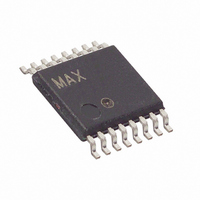MAX9124EUE+T Maxim Integrated Products, MAX9124EUE+T Datasheet - Page 5

MAX9124EUE+T
Manufacturer Part Number
MAX9124EUE+T
Description
IC QUAD LVDS LINE DRIVER 16TSSOP
Manufacturer
Maxim Integrated Products
Type
Driverr
Datasheet
1.MAX9124ESE.pdf
(9 pages)
Specifications of MAX9124EUE+T
Number Of Drivers/receivers
4/0
Protocol
RS644
Voltage - Supply
3 V ~ 3.6 V
Mounting Type
Surface Mount
Package / Case
16-TSSOP
Lead Free Status / RoHS Status
Lead free / RoHS Compliant
The LVDS interface standard is a signaling method
intended for point-to-point communication over a con-
trolled-impedance medium as defined by the
ANSI/TIA/EIA-644 and IEEE 1596.3 standards. The
LVDS standard uses a lower voltage swing than other
common communication standards, achieving higher
data rates with reduced power consumption while
reducing EMI emissions and system susceptibility to
noise.
The MAX9124 is an 800Mbps quad differential LVDS
driver that is designed for high-speed, point-to-point,
and low-power applications. This device accepts
LVTTL/LVCMOS input levels and translates them to
LVDS output signals.
The MAX9124 generates a 2.5mA to 4.0mA output cur-
rent using a current-steering configuration. This current-
steering approach induces less ground bounce and no
shoot-through current, enhancing noise margin and sys-
tem speed performance. The driver outputs are short-
circuit current limited and enter a high-impedance state
when the device is not powered or is disabled.
The current-steering architecture of the MAX9124
requires a resistive load to terminate the signal and
complete the transmission loop. Because the device
switches current and not voltage, the actual output volt-
age swing is determined by the value of the termination
resistor at the input of an LVDS receiver. Logic states
are determined by the direction of current flow through
the termination resistor. With a typical 3.7mA output
current, the MAX9124 produces an output voltage of
370mV when driving a 100Ω load.
Because the MAX9124 is a current-steering device, no
output voltage will be generated without a termination
resistor. The termination resistors should match the dif-
ferential impedance of the transmission line. Output
voltage levels depend upon the value of the termination
resistor. The MAX9124 is optimized for point-to-point
interface with 100Ω termination resistors at the receiver
inputs. Termination resistance values may range
between 90Ω and 132Ω, depending on the characteris-
tic impedance of the transmission medium.
Bypass V
ceramic 0.1µF and 0.001µF capacitors in parallel as
CC
with high-frequency, surface-mount
Applications Information
_______________________________________________________________________________________
Detailed Description
Power-Supply Bypassing
Termination
Table 1. Input/Output Function Table
close to the device as possible, with the smaller valued
capacitor closest to V
Output trace characteristics affect the performance of
the MAX9124. Use controlled-impedance traces to
match trace impedance to the transmission medium.
Eliminate reflections and ensure that noise couples as
common mode by running the differential trace pairs
close together. Reduce skew by matching the electrical
length of the traces. Excessive skew can result in a
degradation of magnetic field cancellation.
Maintain the distance between the differential traces to
avoid discontinuities in differential impedance. Avoid
90° turns and minimize the number of vias to further
prevent impedance discontinuities.
Transmission media should have a nominal differential
impedance of 100Ω. To minimize impedance disconti-
nuities, use cables and connectors that have matched
differential impedance.
Avoid the use of unbalanced cables such as ribbon or
simple coaxial cable. Balanced cables, such as twisted
pair, offer superior signal quality and tend to generate
less EMI due to canceling effects. Balanced cables
tend to pick up noise as common mode, which is
rejected by the LVDS receiver.
For LVDS applications, a four-layer PC board that pro-
vides separate power, ground, LVDS signals, and input
signals is recommended. Isolate the LVTTL/LVCMOS
and LVDS signals from each other to prevent coupling.
TRANSISTOR COUNT: 2007
PROCESS: CMOS
Quad LVDS Line Driver
All other combinations
of ENABLE inputs
EN
L
ENABLES
EN
H
CC
.
Cables and Connectors
INPUTS
IN_
H
Chip Information
X
L
Differential Traces
OUT_+
Board Layout
Z
H
L
OUTPUTS
OUT_ -
H
Z
L
5










